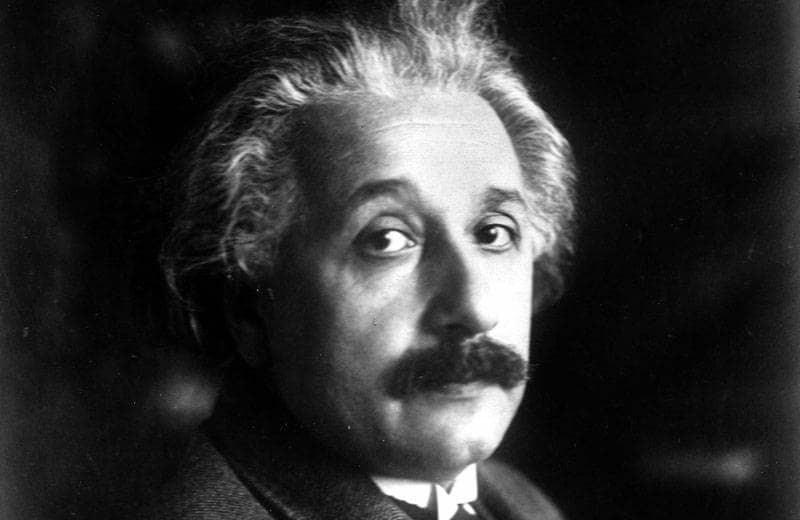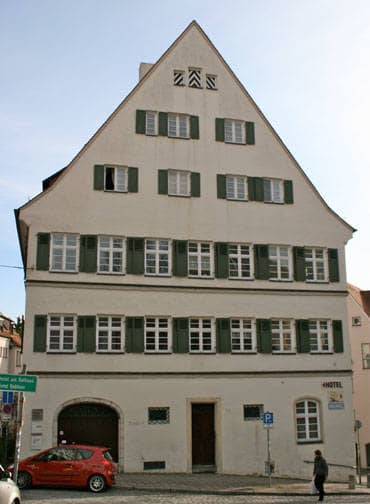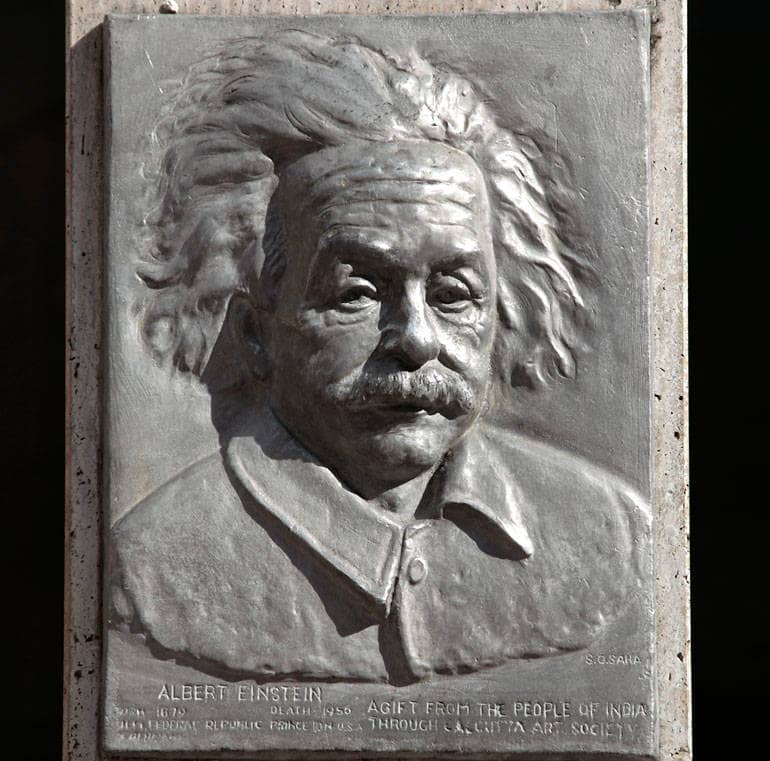Einstein - relative to Ulm

© Ullsteinbild
“Einstein said: Straight or crooked – it’s all relative.” Thus the great physicist’s work has been translated to the vernacular. Maybe not quite comprehensive but easy to comprehend for everyone. Ulm citizens are naturally proud that this world-famous genius was born within the walls of their city. To be precise: in Bahnhofstr. 20, a house reduced to dust by bombs later. However, Einstein was only relatively a relative to Ulm: He was born in Ulm on March 14th 1879, but on June 21st 1880 his father registered the family in Munich where they had relocated in the meantime. In other words: Einstein, who died on April 18th 1955 in Princeton (USA) has spent about 15 months of his 76 years of life in Ulm – a relatively short period of time. However: „The city of birth will be part of your life as well as your descent from your mother. We owe part of our being to our city of birth. Therefore I have grateful memories of Ulm as it represents a liaison of refined artistic tradition and simple, healthy character.”
Einstein gave this polite description of his relation to Ulm to the Ulm Evening Post on March 18th 1929 shortly after his 50th Birthday. Unfortunately he didn’t disclose to the Evening Post which part of his being he was referring to. Was he thinking of the old proverb: “Ulmenses sunt mathematici” (Ulm people are mathematicians) while he gave this statement? Because the old imperial city has indeed produced quite a number of qualified masters of the numbers in the 16th century. One of them was Johannes Faulhaber (1580 – 1635), who is suspected of influencing his more famous contemporary René Descartes (Cartesius). Descartes had his famous three dreams in Ulm on November 10th 1619. These dreams drove him to scientific research of natural phenomenons and this research has found its highest state of development today in mathematical physics. This brings us right back to Einstein, whose exceptional talent actually might have had a touch of the Ulm genius loci.

© Stadt Ulm
Einstein’s father was a merchant. He was a member of the Jewish community which presented their protestant fellow citizens with a stone sculpture, the figure of Jeremiah, part of the sculpture collection in the nave of the Münster Cathedral, celebrating its 500 year anniversary at the time. This generous gift is proof of the accelerated integration of Jewish citizens, which was abruptly and lastingly destroyed by the advent of the National Socialists. This destruction is illustrated by the city’s relation to her famous son. Young Albert had moved on to Italy from Munich with his parents, graduated at the Kanton-school in Aarau (Switzerland), studied at the Swiss Polytechnic in Zurich, received his diploma in 1900 and obtained Swiss citizenship in 1901. His work “About electrodynamics of bodies in motion” was published in 1905 containing his “Specialized Theory of Relativity”. He got his doctorate in the same year, habilitated three years later and began his academic career in 1908 in Bern. His career led him via Zurich and Prague to Berlin. In 1916 he completed his General Theory of Relativity.
Einstein had become famous enough to catch Ulm’s attention. When the press reported about his achievements in 1920 Ulm’s Lord Mayor Dr. Emil Schwamberger enquired at the philosophy faculty of the Tübingen University “if the scientific work of Albert Einstein actually has the significance ascribed to it by the press.” This was the wrong faculty to ask, however the science faculty finally gave the right answer: Einstein was considered “a second Newton”. That was quite good enough. The Ulm city council passed the unanimous decision on February 16th 1920 “to first tender the city’s felicitation in an appropriate manner and hereby establish a relationship to him”. This is exactly what was done and Einstein responded gracefully with a letter of appreciation, honouring “the successful and beneficial land policy” in Ulm, which “has been acknowledged as exemplary nationally and internationally”.
Einstein was awarded the Nobel Prize for Physics in 1922. This news caused the Ulm city council to name one of the new streets “Einsteinstrasse” “in order to honour the Ulm-born creator of the theory of relativity”. When the Lord Mayor told him this in a congratulating letter for his 50th birthday Einstein responded:” I have already heard about this street named after myself. My one consoling thought is that at least I’m not responsible for what is happening and will happen in it.”
Four years later the National Socialists seized power in Germany. Einstein, who had been holding lectures in Princeton (USA) for 3 months each year did not return from a lecture tour. Instead he sent the following declaration in March 1933:
“As long as I have the opportunity I will reside in a country ruled by political freedom, tolerance and equality of all citizens before the law. Political freedom consists of the freedom to articulate one’s political opinion, in speech as well as writing. Tolerance means respect towards all forms of opinion of the individual. At present these conditions are not met in Germany. Persecution endangers those who have contributed much to the prospering international relations, some of them leading artists. Like every individual the social organism can suffer from psychological illness, especially in times of aggravated existence. Nations tend to survive such an illness. I hope that Germany will experience healthy conditions soon and that great men such as Kant and Goethe are not only celebrated occasionally but that the principles they taught will find their way into public life and public conscience.
”The reaction of Ulm’s National Socialists was swift. The Einsteinstrasse was renamed to “Fichtestrasse” in the very same month. One year later Einstein was stripped of his German citizenship.
Persecution of the Jews became more pronounced in Ulm as well. The coming disaster announced itself with a boycott of Jewish shops as early as the spring of 1933. Many of the Ulm Jews believed in a passing nightmare. Alfred Moos , Einstein’s 2nd degree nephew, had however realized what was to follow. He turned to his famous relative for assistance, who did help immediately. He delivered so many immigration sponsorships for the USA to other relatives that they were no longer accepted later on.
Shortly after the liberation from National Socialism the streets in Ulm were liberated from their nazi-reminiscences as well. In that context the Fichtestrasse was renamed back to Einsteinstrasse. When Einstein heard about it a year later, he is said to have remarked: ”This quaint business with the street-name has come to my attention back then and it has quite amused me. It is not known to me if anything has changed in the meantime and I am even less aware when the next change will be happening but I do know how to curb my curiosity. (…) I believe that a neutral name, for example ‘Turnabout street’ would be more appropriate to the German character and would not necessitate a renaming with the course of time.
”When the Ulm city council proposed to award Einstein the Honour-Citizenship in March 1949 to commemorate his 70th birthday, Einstein declined. He was unable to accept such an award in view of the crimes committed against his fellow Jews under Nazi-Rule in Germany. However he didn’t want this rejection made public. He remained consistently polite in his correspondences with Ulm. When Ulm’s Lord Mayor Theodor Pfizer sent him a brochure depicting the celebration of his 50th birthday he expressed his gratitude: “We live in a time of tragic and confusing events. Therefore it makes one twice as happy to see a sign of human kindness”.

© Stadt Ulm
And he kept responding to the annual birthday felicitations from Ulm. With time the city has erected several monuments to her most famous son. The residence of the Ulm adult education center, co-founded by Inge Scholl, sister of resistance-fighters Hans and Sophie Scholl, and her husband, Otl Aicher, was baptized “Einstein-Haus”. During the fifties and sixties it was known as Ulm’s intellectual and democratic center. Max Bill - who founded the legendary collegel of design, again with Inge Scholl and Otl Aicher – erected a memorial in Bahnhofstrasse in 1984. Today the blueprint of Einstein’s birthplace is engraved upon the street surface. Aicher’s memorial is made of 24 granite slabs, twelve of them represent the hours of the day, the other twelve the hours of the night. They symbolize time, arranged in space to resemble a (birth-) house.
Right next to it you will find a memorial plaque with Einstein’s head in the form of a slightly crooked bronze relief and the engraving: ‘a gift from the people of India through Calcutta Art Society’. And finally Einstein sticks his tongue out at us in front of the public administration building on the Zeughaus-areal. There he is part of a bronze fountain sculpture (only the eyes are synthetic) created by Sinsheim’s sculptor Jürgen Gortz in 1984. In addition the city of Ulm awards the annual “City of Ulm Science Award”, endowed with several thousand marks since 1971.
In general, his spirit hovers above the city. Not all who try to engage him however benefit from the experience. Some short time ago in the Einstein-Haus, a public speaker enhanced his speech by slipping in Einstein’s discovery of the relation between mass and speed. This caused a second speaker to add eagerly that Einstein had discovered even more, namely the formula E=mc2.

